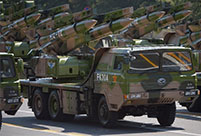

WUHAN, Sept. 7 -- Chinese researchers recently conducted the country's first gas magnetic resonance imaging (MRI) for patients with pulmonary diseases.
Zhou Xin, deputy director of the Wuhan Institute of Physics and Mathematics (WIPM) of Chinese Academy of Sciences, announced the institute's scientific breakthrough on Monday in Wuhan, capital of central China's Hubei Province.
Compared with the traditional computed tomography (CT) which is invasive and can involve radiation, the new method can image lung ventilation defects without harm to the body, providing some of the most advanced imaging technology for early pulmonary diseases.
WIPM is one of a few institutes worldwide that uses gas to improve MRIs.
The researchers, cooperating with the Zhongnan Hospital of Wuhan University, are the only institute nationwide working on a hyperpolarized lung MRI, which aims to "brighten the lungs". Hyperpolarized imaging can provide detailed images of gas exchange in the lungs, which can be used for pre-clinical research on severe pulmonary diseases.
The key to their research is a newly discovered method using a hyperpolarized element known as 129Xe.
Using 129Xe, researchers were able to achieve detailed images far superior to traditional MRIs, which are unable to map the air pockets in the lungs, Zhou said.
"It is an effective supplement of the current imaging methods of lungs," Zhou said.
Currently, chest X-rays, CT and positron emission tomography (PET) are used to check for pulmonary diseases. However, they use radiation to do so and fail to offer detailed gas exchange information.
Early detection of severe pulmonary diseases help save vast health resources and reduce patients' mental and physical pain.
The new technology is still at the pre-clinical step and limited by technology requirements and cost.
Zhou Xin hopes hyperpolarized 129Xe MRI can be put into clinical practice in three to five years. "Before that, we must do several more experiments among patients with lung diseases."
Pulmonary diseases are a prominent health problem in China. According to an annual report released by China's National Health and Family Planning Commission earlier this year, the morbidity and mortality of lung cancer ranks the top among all kinds of cancers.
Compared with 30 years ago, the country's morbidity of lung cancer improved 468 percent.
The morbidity of the chronic obstructive pulmonary disease (COPD), asthma, and pneumoconiosis has also climbed in China, due to air pollution, smoking, and aging.
 Models change clothes on street in Hangzhou
Models change clothes on street in Hangzhou Charming iron ladies in China's upcoming V-Day celebrations
Charming iron ladies in China's upcoming V-Day celebrations In pics: armaments displyed in massive military parade
In pics: armaments displyed in massive military parade Charming Chinese female soldiers
Charming Chinese female soldiers Volunteers required not taller than 5ft 5in
Volunteers required not taller than 5ft 5in  Czech pole dancing master teaches in Xi'an
Czech pole dancing master teaches in Xi'an Shocked! PLA smokescreen vehicle drill
Shocked! PLA smokescreen vehicle drill Foreigners experience tranditional Chinese wedding
Foreigners experience tranditional Chinese wedding Blind date with bikini girls in Nanjing
Blind date with bikini girls in Nanjing The men are taking off
The men are taking off Rights to ratify Dalai restated
Rights to ratify Dalai restated More Chinese having online affairs
More Chinese having online affairs  Who should clean the Arab Spring mess?
Who should clean the Arab Spring mess? Day|Week